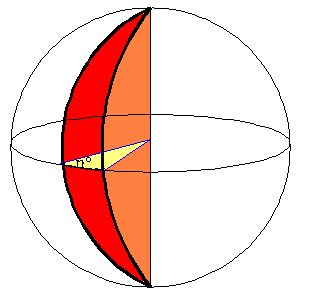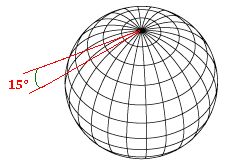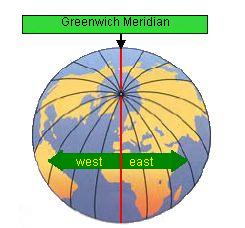SPHERICAL LUNE.
Remember what we studied about the spherical wedge in 15(3).
In the following image, we have a spherical wedge of nº:

It looks like a piece of an orange, doesn't it? However, what is a spherical lune?
A spherical lune would be the crust of that orange piece. It is shown in red in the image above.
As you can see, a Spherical Lune is a part of the spherical surface; it is narrower on its ends than its middle.
Calculating the area of a Spherical Lune is very simple. We will calculate it using a rule of three:
We have already studied that the surface of a sphere is 
This surface correspond to 360º in a complete turn of a semi-circumference. Using this, we will make our rule of three:


15(4).17 What is the surface of a spherical wedge with a radius of 12 cm. and an angle of 35º?
Answer: 
TIME ZONES.
Now, we will use the planet Earth as a sphere. Let's trace as many circumferences (going through the poles) as hours in a day. In other words, let's trace 24 circumferences going through the poles.
If a complete turn of the Earth equals 360º, each part of our planet (corresponding to 1 hour) would equal:

This is shown in the following image:

Two consecutive semi-circumferences of the 24 represent a Spherical Lune corresponding to an angle of 15º. When referring to the planet Earth, we have to talk about Time Zones. Why? As you know, if it's 9 p.m. somewhere in the globe, it is 5 a.m. (the following day) someplace else. It is not convenient for the entire world to be at the same hour. You wouldn't like to see the sun shining at 2 a.m. Every country found between 2 consecutive meridians have the same time. In other words, countries (or parts of them) found in the same Time Zone have the same hour.
We need to determine how to count meridians; to the right or to the left; but, where do we start?
In an international conference held in Washington, in 1884, Greenwich (an observatory in the suburbs of London) was named as the 0 meridian.
In the following image, you can see the Greenwich Meridian. From it, you can see the east (right) and the west (left).
As you can see, Italy is located in a time zone after the one corresponding to Spain. When it is 2 p.m. in Spain, it will be 3 p.m. in Italy. However, the EU (European Union) has adopted the same time zone for every member of this union.
The United Kingdom didn't adhere to this decision.
